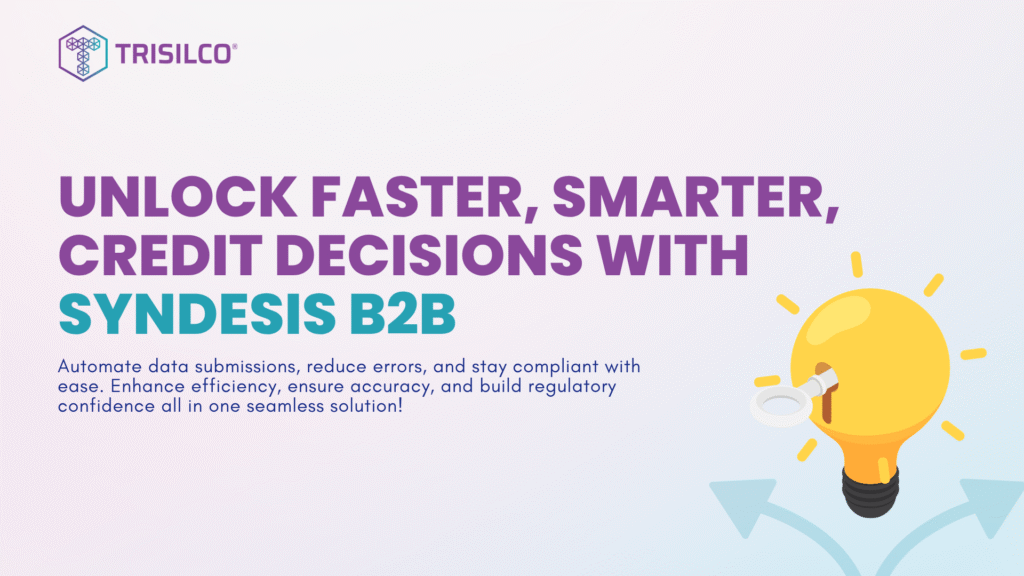Unlock Faster, Smarter Credit Decisions with Syndesis B2B

Conventional credit approval processes are often lengthy, fragmented, and prone to delays—largely due to manual data retrieval, disconnected systems, and time-consuming decision workflows. These outdated techniques increase operating expenses and slow down important decision-making.
Additionally, it’s also increased the risk of human error, which reduces the trustworthiness of procedures. Inconsistent formats, scattered data sources, and manual data gathering add layers of complexity that limit institutions’ ability to function quickly.
This has a direct effect on credit decision-making, an important step in lending and financing. Both institutional success and consumer satisfaction may be impacted by the timing and quality of loan decisions.
To ensure accurate risk assessment, financial institutions must rely on complete and current credit data. Achieving an effective balance requires not only accurate data, but also timely insights that support proactive, well-informed decision-making.
Challenges of Traditional Credit Decisioning
As the need for faster, smarter, and more consistent loan decisions grows, the limitations of manual credit decisioning have become more apparent. Outdated systems struggle to support efficient, scalable workflows—creating bottlenecks that hinder both operational performance and customer responsiveness.
- Slow Processing Times
Standard credit evaluations typically involve collecting client data from several sources, including internal systems, bank statements, and credit bureaus, then manually compiling and evaluating the information. This procedure can be time-consuming and labor-intensive, particularly when handling large numbers of applications. Longer turnaround times and delayed loan approvals are the end results, which eventually lower consumer satisfaction and market competitiveness.
- Inconsistent and Incomplete Data
When credit data is gathered and processed manually, there’s a higher likelihood of errors, delays, or inconsistencies. Disparate systems, lack of real-time integration, and reliance on physical documents can lead to fragmented views of a customer’s financial standing. Without standardized and up-to-date information, credit officers may be working with outdated or incomplete data, increasing the risk of inaccurate assessments.
- Limited Accuracy and Objectivity
Manual credit evaluation frequently uses static standards or subjective assessments, which might not fully reflect an applicant’s creditworthiness. It’s easy to overlook important information like cash flow patterns, recent credit activity, or hidden risk signs. This can lead to approvals for high-risk applicants who might have been alerted, in addition to missing out on loan possibilities for qualified borrowers.
- High Operational Costs and Inefficiencies
Manual processes need a great deal of human labor, teamwork, and task repetition. This puts additional pressure on credit departments and raises operating costs. Additionally, it restricts scalability because it is difficult to replicate the same procedure for higher volumes without matching increasing resources.
The Role of Automation in Enhancing Credit Reporting Efficiency
The challenges highlighted above underscore the need to automate credit decisioning processes. Automation has the potential to transform how financial institutions manage the end-to-end credit lifecycle. For instance, automated workflows simplify the retrieval of credit data from sources such as CCRIS and other Credit Rating Agencies (CRAs).
This allows institutions to speed up processing times and free up internal teams to focus on higher-value tasks. In addition, automated systems also can generate traceable audit trails to help enhance accountability and transparency across the credit reporting process.
By improving internal workflows and enabling faster decision-making, automation leads to shorter response times and a more seamless experience for both internal teams and customers.
As a result, institutions can boost operational efficiency, respond faster to customer needs, and strengthen compliance with evolving regulatory expectations.
Syndesis B2B: Streamlining Credit Decisioning
Syndesis B2B is an intelligent gateway solution designed to streamline and optimize credit credit application processing. It aims to give financial institutions instant access to consumer credit data, enabling more reliable assessments, and providing more intelligent decision-making procedures.
- Real-Time Credit Report Retrieval: Offers instant access to current credit data from sources like CCRIS through Straight-Through Processing (STP). This indicates that organizations make decisions based on the most up-to-date and accurate data.
- Multi-Source Data Integration: Connects with multiple Credit Rating Agencies (CRAs) and CCRIS to generate a complete view of a borrower’s profile.
- Rule-Based Decision Automation: Automates credit evaluations using configurable scorecards and dynamic business rules. Syndesis B2B supports customized business rules and scorecards through integration with advanced decisioning tools, allowing for the early detection or warning of possible credit risks and enhancing decision consistency.
- Increased Efficiency and Speed: Automated credit decisioning significantly speeds up application processing. By automating challenging operations and leveraging real-time data analysis, financial institutions can make judgments immediately. This reduces client wait times and enhances the overall business process.
- Cost Reduction: Reduces the need for human intervention and manual checks, significant cost savings are achieved. Institutions can better deploy resources by focusing on strategic goals rather than challenging administrative tasks.
Syndesis B2B greatly improves the precision and consistency of credit decisions by automating data retrieval, integrating multiple data sources, and allowing smooth review procedures. By enabling financial institutions to deal with high-quality, real-time data, the platform improves risk assessment, speeds up credit evaluation procedures, and minimizes errors.
Conclusion
Financial institutions can revolutionize their credit decisioning procedures by using intelligent automation systems such as Syndesis B2B, which ensure quicker, more precise data extraction and minimize human mistakes.
Workflows are streamlined, rule-based decision-making is supported, and seamless interaction with external credit bureaus is made possible by automation, all of which maintain compliance and enhance operational effectiveness.
Syndesis B2B can assist organizations in cutting expenses, minimizing risks, and accelerating decision-making through real-time data availability and improved decision consistency. This is necessary for financial institutions to remain competitive and provide exceptional customer experiences as they continue to manage the changing regulatory and market demands.
To find out how Syndesis B2B can improve your credit decisioning process, get in touch with us at marketing@trisilco.com.